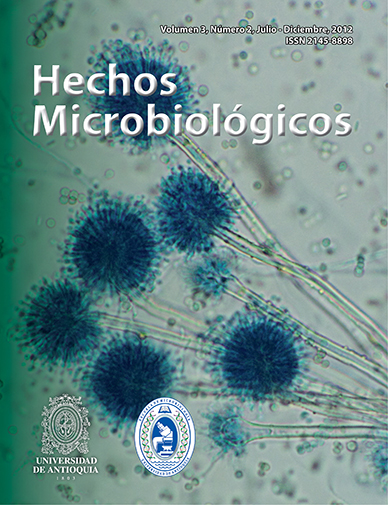Assessment of the infection of ticks Rhipicephalus (Boophilus) microplus by Babesia spp., and the infestation in cattle of 3-9 months in the Magdalena area during the rainy season of 2010
DOI:
https://doi.org/10.17533/udea.hm.18735Keywords:
babesia/parasitology, diseases transmitted by ticks, ticks, cattle, Rhipicephalus microplusAbstract
Downloads
References
Ravindran R, Rao JR, Mishra AK. Detection of Babe-sia bigemina DNA in ticks by DNA hybridization using a nonradioactive probe generated by arbitrary PCR. Vet Parasitol. 2006 Oct 10; 141(1-2):181-5.
Meléndez RD. Revisión integral de los factores epi-demiológicos que inciden en la relación Boophilus microplus - bovino – Babesia. Revista Científica, FCV-LUZ/Vol. VIII 1998; 1:25-34.
suárez M, Méndez l, Valdez M, Moura s, Camargo A, Vargas n, Ascanio. En: Control de las infestaciones de la garrapata Boophilus microplus en la ganadería Cu-bana y en regiones de Latinoamérica con la aplicación del inmunógeno Gavac® dentro de un programa de lucha integral [en línea]. Sexta Conferencia Electrónica. Red Electrónica de Garrapatas y Enfermedades Trans-mitidas por Garrapatas para América Latina y el Caribe, RedEctopar. 2007. [Fecha de consulta: 25 de Febrerode 2009]. Disponible en: http://www.corpoica.gov.co/SitioWeb/Archivos/Conferencias/Vacs1Cuba.pdf
Vizcaino G. Anaplasmosis y babesiosis en ganado bovino. En: Control de garrapatas. Compendio Nº 39. ICA. Medellín. 1980: 59-79.
Gómez l. La Frontera Antioquia-Santander. Las fronteras de Antioquia. Aspectos físicos, jurídicos, históricos, económicos y socioculturales. Departamento Administrativo de Planeación. Gobernación de Antioquia. 1-80 pp. 2005.
Cardona C, Hoyos J, tabares J. Estabilidad enzoótica para Babesiosis bovina desde la Microbiología y el Bioanálisis. Tesis de grado. Escuela de Microbiología, Universidad de Antioquia. Medellín. 2007.
García D, Álvarez J, Figueroa J, Vega A. Babesiosis bovina: características relevantes de la respuesta inmune. Ciencia Veterinaria 9 -2003 -4: 105-122.
Ríos l, Zapata R, Reyes J, Mejía J, baena A. Estabilidad enzoótica de babesiosis bovina en la región de Puerto Berrío, Colombia. Revista Científica, FCV-LUZ / Vol. XX, Nº 5, 485-492, 2010.
Álvarez V, bonilla R, Chacón I. Frecuencia relativa de Boophilusmicroplus (Acari: Ixodidae) en bovinos (Bostaurusy B. indicus) en ocho zonas ecológicas de Costa Rica. Revista de Biología tropical. 2003; 51, (2): 427-434.
Burgdorfer W. Hemolymph test a technique for detection of rickettsiae in ticks. The American journal of Tropical Medicine and Hygiene. 1970; 19(6): 1010-1014.
Guglielmone A, Gaido A, Mangold A. Light Microscopy Diagnosis of Babesia bovis and B. bigeminaKinetes in the Hemolymph of Artificially Infected Boo-philus microplus Engorged Female Ticks”. En: Veteri-nary Parasitology. 1996; 61 (1-2): 15-20.
Morzaria sP, brocklesby DW. A differential diagnostic criterion for Babesia major and Babesia bigeminavermicules from tick haemolymph. Z. Parasitenkd. 1977; 52: 241-243.
Ribera H, Cuéllar A, barba G, Carrique J, Walker A. Estudio sobre babesiosis y anaplasmosis en relación con la carga de garrapatas en terneros lecheros del oriente boliviano. En: Vet. Méx. 2000; 31(1): 39-46.
Solorio – Rivera Jl, Rodríguez R. Epidemiología de la Babesiosis bovina II. Indicadores epidemiológicos y elementos para el desarrollo de estrategias de control. En: Rev Biomed 1997; 8: 95-105.
Quintão M, Múcio s. Infection Rate of Babesia spp. Sporokinetes in Engorged Boophilusmicroplus from an Area of Enzootic Stability in the State of Minas Gerais, Brazil. En: Memorias do Instituto Oswaldo Cruz. 2003; 98(08): 999-1002.








